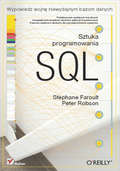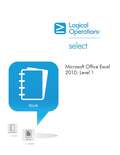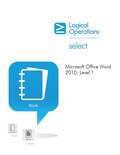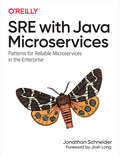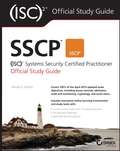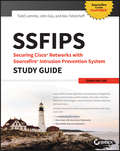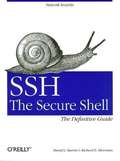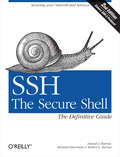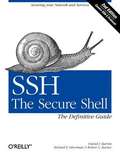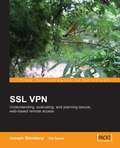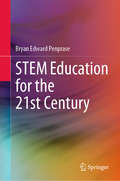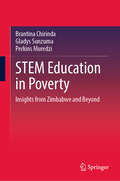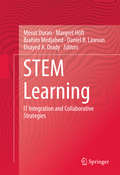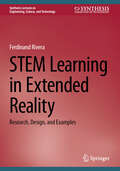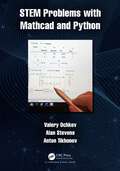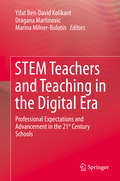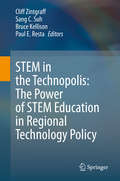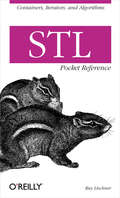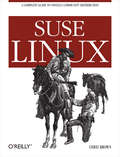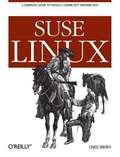- Table View
- List View
SQL- & NoSQL-Datenbanken: 9. erweiterte und aktualisierte Auflage
by Michael Kaufmann Andreas MeierDie Autoren führen in relationale (SQL) und nicht-relationale (NoSQL) Datenbanken ein. Die 9. Auflage erklärt die drei Typen relationale Datenbanken, Graphdatenbanken und Dokumentdatenbanken im Detail anhand der Themen Datenbankmanagement, Datenbankmodellierung, Datenbanksprachen, Datenbanksicherheit und Systemarchitektur. Das Buch bietet außerdem einen Überblick auf postrelationale und nicht-relationale Datenbanksysteme.In den ersten fünf Kapiteln analysieren die Autoren detailliert die Verwaltung, Modellierung, Sprachen, Sicherheit und Architektur von relationalen Datenbanken, Graphdatenbanken und Dokumentendatenbanken. Außerdem wird ein Überblick über andere SQL- und NoSQL-basierte Datenbankansätze gegeben. Neben klassischen Konzepten wie dem Entitäts- und Beziehungsmodell und seiner Abbildung in SQL-Datenbankschemata, Abfragesprachen oder dem Transaktionsmanagement werden weitere Aspekte für NoSQL-Datenbanken wie nicht-relationale Datenbankschemas und Abfragesprachen (MQL, Cypher), das Map/Reduce-Verfahren, Verteilungsoptionen (Sharding, Replikation) oder das CAP-Theorem (Consistency, Availability, Partition Tolerance) erläutert.Die 9. Auflage bietet neu eine vertiefte Einführung in Dokumentdatenbanken mit einer Methode zur Modellierung von Dokumentstrukturen, einem Überblick auf dokumentenorientierte Datenbanksprache MongoDB Query Language MQL sowie Sicherheits- und Architekturaspekte. Die neue Auflage berücksichtigt neue Entwicklungen der Sprache Cypher. Das Thema Datenbanksicherheit wird neu als eigenes Kapitel eingeführt und im Detail bezüglich Datenschutz, Integrität und Transaktionen analysiert. Texte zum Datenmanagement, zur Datenbankprogrammierung und zum Data Warehouse wurden aktualisiert. Zudem erklärt die 9. Auflage die Konzepte JSON, JSON-Schema, BSON, indexfreie Nachbarschaft, Cloud-Datenbanken, Suchmaschinen und Zeitreihendatenbanken.Eine Webseite ergänzt den Inhalt des Buches durch Tutorien für Abfrage- und Manipulationssprachen (SQL, Cypher), Übungsumgebungen für Datenbanken (MySQL, Neo4j), zwei Fallstudien mit OpenOffice Base und Neo4j sowie als Unterrichtsmaterial Folienvorlagen mit allen Abbildungen Das Buch richtet sich sowohl an Studierende, die eine Einführung in das Gebiet der SQL- und NoSQL-Datenbanken möchten, als auch auch an Praktiker in Datenwissenschaften und Informatik, denen es hilft, Stärken und Schwächen relationaler und nicht-relationaler Ansätze sowie Entwicklungen für Big-Data-Anwendungen besser einschätzen zu können
SQL. Sztuka programowania
by Stephane Faroult Peter RobsonWypowiedz wojn? niewydajnym bazom danych Projektowanie wydajnych baz danych Uwzgl?dnianie kontekstu dzia?ania aplikacji bazodanowych Poprawa szybko?ci dzia?ania ?le zaprojektowanych systemów Twoje bazy danych dzia?aj? zbyt wolno? Pora to zmieni?! Wraz ze wzrostem wielko?ci korporacyjnych baz danych czas dost?pu do nich ma coraz wi?ksze znaczenie. Napisanie poprawnie dzia?aj?cego kodu w j?zyku SQL nie jest trudne, jednak tworzenie wydajnych aplikacji bazodanowych jest prawdziw? sztuk?. Jak mo?esz zg??bi? jej tajniki i sta? si? lepszym programist?? Zdaniem autora tej ksi??ki nauka wydajnej pracy z bazami danych przypomina poznawanie zasad prowadzenia wojny, dlatego wzorem klasycznej pozycji "Sztuka wojny" autorstwa Sun Tzu prowadzi Ci? on przez poszczególne etapy kampanii przeciwko nieefektywnie zaprojektowanym i napisanym aplikacjom bazodanowym. "SQL. Sztuka programowania" to praktyczny podr?cznik, dzi?ki któremu szybko poszerzysz sw? wiedz? w zakresie efektywnego stosowania j?zyka SQL. Nauczysz si? dba? o wydajno?? aplikacji ju? na etapie ich projektowania, a tak?e my?le? o pracy z bazami danych w kategoriach procesów, wykraczaj?c poza same zapytania j?zyka SQL. Dowiesz si?, jak poprawnie u?ywa? indeksów oraz jak monitorowa? szybko?? dzia?ania bazy. Poznasz standardowe scenariusze zwi?kszania wydajno?ci, które pozwol? Ci zastosowa? sprawdzone fortele we w?asnych projektach oraz w bazach zaprojektowanych przez innych programistów. Projektowanie pod k?tem wydajno?ci Efektywne korzystanie z baz danych w programach Poprawne stosowanie indeksów Projektowanie optymalnych zapyta? SQL Praca z du?ymi zbiorami danych Korzystanie ze struktur drzewiastych Monitorowanie wydajno?ci Obs?uga wspó?bie?no?ci Radzenie sobie z niewydajnymi projektami Poznaj praktyczne techniki poprawy wydajno?ci baz danych.
SR Microsoft® Office Excel® 2010: 084576s3
by Element KMicrosoft® Office Excel® 2010: 084576s3 helps you possess some basic computer skills and are comfortable with using a computer to perform basic tasks. You may have used a calculator and paper to record data and per¬form calculations, and now want to migrate to using a computer application to store and process data in an electronic format. In this course, you will use Microsoft® Office Excel® 2010 to create spreadsheets that you can use to perform these tasks.
SR Microsoft® Office Word 2010: Level 1
by Element KIn this course, you will examine the basic concepts of creating a document, editing a document and enhancing a document and its contents by using the Microsoft® Office Word 2010 application.
SRE with Java Microservices: Patterns For Reliable Microservices In The Enterprise
by Jonathan SchneiderIn a microservices architecture, the whole is indeed greater than the sum of its parts. But in practice, individual microservices can inadvertently impact others and alter the end user experience. Effective microservices architectures require standardization on an organizational level with the help of a platform engineering team.This practical book provides a series of progressive steps that platform engineers can apply technically and organizationally to achieve highly resilient Java applications. Author Jonathan Schneider covers many effective SRE practices from companies leading the way in microservices adoption. You’ll examine several patterns discovered through much trial and error in recent years, complete with Java code examples.Chapters are organized according to specific patterns, including:Application metrics: Monitoring for availability with MicrometerDebugging with observability: Logging and distributed tracing; failure injection testingCharting and alerting: Building effective charts; KPIs for Java microservicesSafe multicloud delivery: Spinnaker, deployment strategies, and automated canary analysisSource code observability: Dependency management, API utilization, and end-to-end asset inventoryTraffic management: Concurrency of systems; platform, gateway, and client-side load balancing
SRv6 Network Programming: Ushering in a New Era of IP Networks (Data Communication Series)
by Cheng Li Zhenbin Li Zhibo HuSRv6 Network Programming, beginning with the challenges for Internet Protocol version 6 (IPv6) network development, describes the background, roadmap design, and implementation of Segment Routing over IPv6 (SRv6), as well as the application of this technology in traditional and emerging services. The book begins with the development of IP technologies by focusing on the problems encountered during MPLS and IPv6 network development, giving readers insights into the problems tackled by SRv6 and the value of SRv6. It then goes on to explain SRv6 fundamentals, including SRv6 packet header design, the packet forwarding process, protocol extensions such as Interior Gateway Protocol (IGP), Border Gateway Protocol (BGP), and Path Computation Element Protocol (PCEP) extensions, and how SRv6 supports existing traffic engineering (TE), virtual private networks (VPN), and reliability requirements. Next, SRv6 network deployment is introduced, covering the evolution paths from existing networks to SRv6 networks, SRv6 network deployment processes, involved O&M technologies, and emerging 5G and cloud services supported by SRv6. Bit Index Explicit Replication IPv6 encapsulation (BIERv6), an SRv6 multicast technology, is then introduced as an important supplement to SRv6 unicast technology. The book concludes with a summary of the current status of the SRv6 industry and provides an outlook for new SRv6-based technologies. SRv6 Network Programming: Ushering in a New Era of IP Networks collects the research results of Huawei SRv6 experts and reflects the latest development direction of SRv6. With rich, clear, practical, and easy-to-understand content, the volume is intended for network planning engineers, technical support engineers and network administrators who need a grasp of the most cutting-edge IP network technology. It is also intended for communications network researchers in scientific research institutions and universities. Authors: Zhenbin Li is the Chief Protocol Expert of Huawei and member of the IETF IAB, responsible for IP protocol research and standards promotion at Huawei. Zhibo Hu is a Senior Huawei Expert in SR and IGP, responsible for SR and IGP planning and innovation. Cheng Li is a Huawei Senior Pre-research Engineer and IP standards representative, responsible for Huawei's SRv6 research and standardization.
SSA-based Compiler Design
by Fabrice Rastello Florent Bouchez TichadouThis book provides readers with a single-source reference to static-single assignment(SSA)-based compiler design. It is the first (and up to now only) book that coversin a deep and comprehensive way how an optimizing compiler can be designed usingthe SSA form. After introducing vanilla SSA and its main properties, the authorsdescribe several compiler analyses and optimizations under this form. They illustratehow compiler design can be made simpler and more efficient, thanks to the SSA form.This book also serves as a valuable text/reference for lecturers, making the teaching ofcompilers simpler and more effective. Coverage also includes advanced topics, such ascode generation, aliasing, predication and more, making this book a valuable referencefor advanced students and practicing engineers.
SSCP (ISC)2 Systems Security Certified Practitioner Official Study Guide
by George MurphyFully updated Study Guide for the SSCP This guide prepares you for the SSCP, Systems Security Certified Practitioner certification examination by focusing on the Common Body of Knowledge (CBK) as determined by ISC2 in seven high level topics. This Sybex Study Guide covers 100% of all exam objectives. You'll prepare for the exam smarter and faster with Sybex thanks to expert content, real-world practice, access to the Sybex online interactive learning environment and much more. Reinforce what you've learned with key topic exam essentials and chapter review questions. Along with the book you also get access to Sybex's superior online interactive learning environment that includes: 125 question practice exam to help you identify where you need to study more. Get more than 90 percent of the answers correct, you're ready to take the certification exam. More than 100 Electronic Flashcards to reinforce your learning and give you last minute test prep before the exam A searchable glossary in PDF to give you instant access to the key terms you need to know for the exam Appendix of charts, tables, typical applications, and programs Coverage of all of the exam topics in the book means you'll be ready for: Access Controls Security Operations and Administration Risk Identification, Monitoring and Analysis Incident Response and Recovery Cryptography Network and Communications Security Systems and Application Security
SSFIPS Securing Cisco Networks with Sourcefire Intrusion Prevention System Study Guide
by John Gay Todd Lammle Alex TatistcheffUp the ante on your Sourcefire IPS exam prep Securing Cisco Networks with Sourcefire IPS Study Guide, Exam 500-285 provides 100% coverage of the Securing Cisco Networks with Sourcefire IPS exam objectives. With clear and concise information regarding crucial security topics, this comprehensive guide includes practical examples and insights drawn from real-world experience, exam highlights, and end of chapter reviews. Learn key exam topics and powerful features of the Cisco Sourcefire System, including FireSIGHT technology, in-depth event analysis, IPS tuning and configuration, and snort rules language. Gain access to Sybex's superior online learning environment that includes practice questions, flashcards, and interactive glossary of terms. Use and configure next-generation Sourcefire technology, including application control, firewall, and routing and switching capabilities Understand how to accurately tune your systems to improve performance and network intelligence while leveraging powerful tools for more efficient event analysis Complete hands-on labs to reinforce key concepts and prepare you for the practical applications portion of the examination Access Sybex's online interactive learning environment and test bank, which includes an assessment test, chapter tests, bonus practice exam questions, electronic flashcards, and a searchable glossary Securing Cisco Networks with Sourcefire IPS Study Guide, Exam 500-285 provides you with the information you need to prepare for the Sourcefire IPS examination.
SSH, The Secure Shell: The Definitive Guide
by Daniel J. Barrett Richard SilvermanSSH (Secure Shell) is a popular, robust, TCP/IP-based product for network security and privacy, supporting strong encryption and authentication. This book covers Unix, Windows, and Macintosh implementations of SSH. It shows both system administrators and end users how to install, maintain, and troubleshoot SSH; configure servers and clients in simple and complex ways; apply SSH to practical problems; and protect other TCP applications through forwarding (tunneling).
SSH, The Secure Shell: The Definitive Guide
by Daniel J. Barrett Robert G. Byrnes Richard E. SilvermanAre you serious about network security? Then check out SSH, the Secure Shell, which provides key-based authentication and transparent encryption for your network connections. It's reliable, robust, and reasonably easy to use, and both free and commercial implementations are widely available for most operating systems. While it doesn't solve every privacy and security problem, SSH eliminates several of them very effectively.Everything you want to know about SSH is in our second edition of SSH, The Secure Shell: The Definitive Guide. This updated book thoroughly covers the latest SSH-2 protocol for system administrators and end users interested in using this increasingly popular TCP/IP-based solution.How does it work? Whenever data is sent to the network, SSH automatically encrypts it. When data reaches its intended recipient, SSH decrypts it. The result is "transparent" encryption-users can work normally, unaware that their communications are already encrypted. SSH supports secure file transfer between computers, secure remote logins, and a unique "tunneling" capability that adds encryption to otherwise insecure network applications. With SSH, users can freely navigate the Internet, and system administrators can secure their networks or perform remote administration.Written for a wide, technical audience, SSH, The Secure Shell: The Definitive Guide covers several implementations of SSH for different operating systems and computing environments. Whether you're an individual running Linux machines at home, a corporate network administrator with thousands of users, or a PC/Mac owner who just wants a secure way to telnet or transfer files between machines, our indispensable guide has you covered. It starts with simple installation and use of SSH, and works its way to in-depth case studies on large, sensitive computer networks.No matter where or how you're shipping information, SSH, The Secure Shell: The Definitive Guide will show you how to do it securely.
SSH, the Secure Shell, 2nd Edition
by Daniel J. Barrett Robert G. Byrnes Richard SilvermanAre you serious about network security? Then check out SSH, the Secure Shell, which provides key-based authentication and transparent encryption for your network connections. It's reliable, robust, and reasonably easy to use, and both free and commercial implementations are widely available for most operating systems. While it doesn't solve every privacy and security problem, SSH eliminates several of them very effectively. Everything you want to know about SSH is in our second edition of SSH, The Secure Shell: The Definitive Guide . This updated book thoroughly covers the latest SSH-2 protocol for system administrators and end users interested in using this increasingly popular TCP/IP-based solution. How does it work? Whenever data is sent to the network, SSH automatically encrypts it. When data reaches its intended recipient, SSH decrypts it. The result is "transparent" encryption-users can work normally, unaware that their communications are already encrypted. SSH supports secure file transfer between computers, secure remote logins, and a unique "tunneling" capability that adds encryption to otherwise insecure network applications. With SSH, users can freely navigate the Internet, and system administrators can secure their networks or perform remote administration. Written for a wide, technical audience, SSH, The Secure Shell: The Definitive Guide covers several implementations of SSH for different operating systems and computing environments. Whether you're an individual running Linux machines at home, a corporate network administrator with thousands of users, or a PC/Mac owner who just wants a secure way to telnet or transfer files between machines, our indispensable guide has you covered. It starts with simple installation and use of SSH, and works its way to in-depth case studies on large, sensitive computer networks. No matter where or how you're shipping information, SSH, The Secure Shell: The Definitive Guide will show you how to do it securely.
SSL VPN: Understanding, evaluating and planning secure, web-based remote access
by Joseph SteinbergThe book blends technically rigorous descriptions with a friendly approach based on practical examples and scenarios. The authors write in clear, informal language and make extensive use of diagrams and images. The book begins with an overview of SSL VPN?s purpose, and the technical and business trends that are making it popular today. It then looks at how SSL VPNs work and how they fit into existing network plans. The effect of SSL VPN on the wider business environment is then considered, before looking at how SSL VPN technology is likely to develop in the future. This book aimed at IT network professionals and managers who are currently evaluating SSL VPN technologies. It requires a broad understanding of networking concepts, but does not require specific and detailed technical knowledge of protocols or vendor implementations.
STEAM Education: Theory and Practice
by Myint Swe Khine Shaljan AreepattamannilThis book looks at the value of integrating the arts and sciences in the school curriculum. It argues that this will help students further their understanding of analytical concepts through the use of creativity. The authors illustrate how schools can work towards presenting common practices, concepts, and content. Coverage features case studies and lessons learned from classrooms across the United States.The notion of STEAM (Science, Technology, Engineering, Arts, and Mathematics) is an emerging discipline unique in its desire to provide a well-rounded approach to education. The chapters of this volume examine STEAM in a variety of settings, from kindergarten to higher education. Readers will learn about the practical considerations involved when introducing the arts and creativity into traditionally left brain processes. This includes best practices for creating and sustaining successful STEAM initiatives in any school, college, or university. For instance, one chapter discusses novel approaches to teach writing with the scientific method in order to help students better present their ideas. The authors also detail how the arts can engage more diverse learners, including students who are not traditionally interested in STEM subjects. They provide three concrete examples of classroom-tested inquiries: designing a prosthetic arm for a child, making a paleontology investigation, and taking a closer look at the arts within roller coaster engineering. This book is an invaluable resource for teachers and teacher trainers, university faculty, researchers, and school administrators. It will also be of interest to science, mathematics, engineering, computer science, information technology, arts and design and technology teachers.
STEM Education for the 21st Century (Springerbriefs In Education Ser.)
by Bryan Edward PenpraseThis book chronicles the revolution in STEM teaching and learning that has arisen from a convergence of educational research, emerging technologies, and innovative ways of structuring both the physical space and classroom activities in STEM higher education. Beginning with a historical overview of US higher education and an overview of diversity in STEM in the US, the book sets a context in which our present-day innovation in science and technology urgently needs to provide more diversity and inclusion within STEM fields. Research-validated pedagogies using active learning and new types of research-based curriculum is transforming how physics, biology and other fields are taught in leading universities, and the book gives profiles of leading innovators in science education and examples of exciting new research-based courses taking root in US institutions. The book includes interviews with leading scientists and educators, case studies of new courses and new institutions, and descriptions of site visits where new trends in 21st STEM education are being developed. The book also takes the reader into innovative learning environments in engineering where students are empowered by emerging technologies to develop new creative capacity in their STEM education, through new centers for design thinking and liberal arts-based engineering. Equally innovative are new conceptual frameworks for course design and learning, and the book explores the concepts of Scientific Teaching, Backward Course Design, Threshold Concepts and Learning Taxonomies in a systematic way with examples from diverse scientific fields. Finally, the book takes the reader inside the leading centers for online education, including Udacity, Coursera and EdX, interviews the leaders and founders of MOOC technology, and gives a sense of how online education is evolving and what this means for STEM education. This book provides a broad and deep exploration into the historical context of science education and into some of the cutting-edge innovations that are reshaping how leading universities teach science and engineering. The emergence of exponentially advancing technologies such as synthetic biology, artificial intelligence and materials sciences has been described as the Fourth Industrial Revolution, and the book explores how these technologies will shape our future will bring a transformation of STEM curriculum that can help students solve many the most urgent problems facing our world and society.
STEM Education in Poverty: Insights from Zimbabwe and Beyond
by Brantina Chirinda Gladys Sunzuma Perkins MuredziThis book is about Science, Technology, Engineering, and Mathematics (STEM) education in poverty and the lessons we learn from Zimbabwe. The world is driving towards the fourth Industrial Revolution (4IR), where economic growth has been attributed to STEM education. STEM education is vital in this era, where both developed and developing countries are undergo rapid changes. Globally, STEM education has been practised differently in schools and universities. University programs, new school curricula, instructional methods, extracurricular programs, and professional development programs for in-service teachers have been created to cater to STEM subjects. STEM education is envisioned to produce critical thinkers, inventors, creators, problem solvers, innovators, and professionals who will solve the world’s ever-changing challenges, including inequity, food insecurity, climate change, inequality, and poverty. STEM is essential to modern education. Zimbabwe has faced significant economic challenges but has made remarkable strides in STEM education. By examining the successes and challenges of STEM education in Zimbabwe, we can learn valuable lessons about improving STEM education in underserved communities. This book contributes to the international debate surrounding the optimal STEM education for students in underserved schools. It incorporates detailed accounts of STEM education in Zimbabwe schools, shedding light on the challenges students and educators face in impoverished areas. In Zimbabwe, STEM education faces significant challenges such as materials and facilities, pedagogy, policy reform, access, and relevance. Some of the main issues highlighted in this book are the need for more resources, including funding, teaching materials, and adequate laboratories. Effective STEM pedagogy is hampered by an education system that emphasises the curriculum and teacher-centred focus instead of focusing on how students can be taught or learn. Research has shown that in Zimbabwe, STEM teachers must apply inventive pedagogies and suitable learner-centred STEM teaching approaches. As a result, there is a need for more STEM-related programs and courses in schools and universities to improve the opportunities for students to pursue careers in these fields. Another challenge is the need for more awareness about the opportunities and importance of STEM education and interest in STEM subjects among students, which can be attributed to a lack of exposure and understanding of the relevance and importance of these fields in today's world. While lack of resources and other challenges hinder effectiveness, opportunity lies in promising pathways of policy and practice. In Zimbabwe, there is a varying degree of success in the implemented competence-based curriculum, which emphasises inquiry-based learning and STEM education. Finally, there is a need for early exposure to STEM-based career opportunities and for more collaboration between the government, private sector, and educational institutions to address these challenges and promote STEM education in Zimbabwe. This book uses Zimbabwe as an example to explore STEM education in poverty. By examining the successes and challenges of STEM education in Zimbabwe, this book offers valuable insights into how STEM education can be integrated into the curriculum in countries with developing and emerging economies. This book is an essential resource for anyone interested in improving STEM education in underserved communities.
STEM Learning
by Mesut Duran Margret Höft Brahim Medjahed Daniel B. Lawson Elsayed A. OradyThis book reports the results of a three-year research program funded by the National Science Foundation which targeted students and teachers from four Detroit high schools in order for them to learn, experience, and use IT within the context of STEM (IT/STEM), and explore 21st century career and educational pathways. The book discusses the accomplishment of these goals through the creation of a Community of Designers-- an environment in which high school students and teachers, undergraduate/graduate student assistants, and STEM area faculty and industry experts worked together as a cohesive team. The program created four project-based design teams, one for each STEM area. Each team had access to two year-round IT/STEM enrichment experiences to create high-quality learning projects, strategies, and curriculum models. These strategies were applied in after school, weekend, and summer settings through hands-on, inquiry-based activities with a strong emphasis on non-traditional approaches to learning and understanding. The book represents the first comprehensive description and analysis of the research program and suggests a plan for future development and refinement.
STEM Learning in Extended Reality: Research, Design, and Examples (Synthesis Lectures on Engineering, Science, and Technology)
by Ferdinand RiveraThis book synthesizes findings from recent and ongoing research on the use of Extended Reality (XR) to support learning of STEM content. XR is slowly being introduced in classrooms due to significant changes in XR technology. These tools were historically costly, unfriendly, and developed only for gamers. Today, XR tools are able to enhance students’ immersive experiences in such settings. In classrooms, in particular, they provide learners with an opportunity to manipulate abstract objects as if they are physical objects. The book begins with an extensive and detailed description and evaluation of the impact of various XR interventions on learning and engagement in STEM classrooms. The author then concludes with theoretical frameworks for investigating learning in computer- immersive contexts and practical implications for effectively using XR tools to learn STEM.
STEM Problems with Mathcad and Python
by Valery Ochkov Alan Stevens Anton TikhonovSTEM Problems with Mathcad and Python seeks to remove the fear of tackling difficult scientific and technical calculations for future mathematicians, engineers, scientists, and other STEM researchers. The authors hope to show that such calculations can be not only useful, but that the process of learning how to do them can be enjoyable, especially with the help of Mathcad and Python programming skills. The book will also illustrate how the use of modern computer software allows one to significantly expand the range of problems considered beyond those conventionally taught. This includes computational experiments, multivariate calculations, inverse problems and optimization problems, with both static and animated visual feedback. Features Suitable for undergraduates and early postgraduates who need simple and accessible guidance for solving practical interdisciplinary technical problems Can be used as an additional textbook in a variety of topics, including Calculus, Linear Algebra, Analytical Geometry, Discrete Mathematics, Computer Science, Computational Mathematics, Scientific Visualization, Computer Graphics Gives computer users access to an exciting new hobby - solving complex problems described in fiction.
STEM Teachers and Teaching in the Digital Era: Professional Expectations and Advancement in the 21st Century Schools
by Dragana Martinovic Yifat Ben-David Kolikant Marina Milner-BolotinThis book brings together researchers from Israel and Canada to discuss the challenges today's teachers and teacher‐educators face in their practice.There is a growing expectation that the 21st century STEM teachers re‐examine their teaching philosophies and adjust their practices to reflect the increasing role of digital technologies. This expectation presents a significant challenge to teachers, who are often asked to implement novel technology‐rich pedagogies they did not have a chance to experience as students or become comfortable with. To exacerbate this challenge, the 21st century teachers function not only in a frequently‐changing educational reality manifested by continuous reforms, but are also bombarded by often contradictory and competing demands from the legislators, administrators, parents, and students. How do we break the vicious circle of reforms and support STEM teachers in making a real change in student learning? This book is unique for at least three reasons. First, it showcases research situated in Israel and Canada that examines the challenges today's teachers and teacher‐educators face in their practice. While the governments of both countries emphasize STEM education, their approaches are different and thus provide for interesting comparisons. Second, in addition to including research-based chapters, prominent scholars discuss the contributions in each of the book sections, problematizing the issues from a global perspective. Third, technology has a potential to empower teachers in this era of change, and this book provides the unique insights from each country, while allowing for comparisons, discussing solutions, and asking new questions.This book will be of interest to all involved in STEM teacher education programs or graduate programs in education, as well as to educational administrators interested in implementing technology in their schools.
STEM in the Technopolis: The Power of STEM Education in Regional Technology Policy
by Sang C. Suh Cliff Zintgraff Bruce Kellison Paul E. RestaThis book addresses how forward-thinking local communities are integrating pre-college STEM education, STEM pedagogy, industry clusters, college programs, and local, state and national policies to improve educational experiences, drive local development, gain competitive advantage for the communities, and lead students to rewarding careers. This book consists of three sections: foundational principles, city/regional case studies from across the globe, and state and national context. The authors explore the hypothesis that when pre-college STEM education is integrated with city and regional development, regions can drive a virtuous cycle of education, economic development, and quality of life.Why should pre-college STEM education be included in regional technology policy? When local leaders talk about regional policy, they usually talk about how government, universities and industry should work together. This relationship is important, but what about the hundreds of millions of pre-college students, taught by tens of millions of teachers, supported by hundreds of thousands of volunteers, who deliver STEM education around the world? Leaders in the communities featured in STEM in the Technopolis have recognized the need to prepare students at an early age, and the power of real-world connections in the process. The authors advocate for this approach to be expanded. They describe how STEM pedagogy, priority industry clusters, cross-sector collaboration, and the local incarnations of global development challenges can be made to work together for the good of all citizens in local communities. This book will be of interest to government policymakers, school administrators, industry executives, and non-profit executives. The book will be useful as a reference to teachers, professors, industry professional volunteers, non-profit staff, and program leaders who are developing, running, or teaching in STEM programs or working to improve quality of life in their communities.
STL Pocket Reference
by Ray LischnerThe STL Pocket Reference describes the functions, classes, and templates in that part of the C++ standard library often referred to as the Standard Template Library (STL). The STL encompasses containers, iterators, algorithms, and function objects, which collectively represent one of the most important and widely used subsets of standard library functionality. The C++ standard library, even the subset known as the STL, is vast. It's next to impossible to work with the STL without some sort of reference at your side to remind you of template parameters, function invocations, return types--indeed, the entire myriad of details you need to know in order to use the STL effectively and get work done. You need a memory-aid. Books that cover the standard library and the STL tend to be quite heavy and large, describing each aspect of the STL in detail. Such books are great when you're not familiar with the library, but get in the way when you simply need to remind yourself of a function name, or the order in which you pass arguments to a function. Programmers familiar with the STL need a small, lightweight memory-aid. That's what the STL Pocket Reference is. It's small, lightweight, and chock-full of information that you can take in at a glance, so you can get on with your work.
STL Pocket Reference: Containers, Iterators, and Algorithms (Pocket Reference (O'Reilly))
by Ray LischnerThe STL Pocket Reference describes the functions, classes, and templates in that part of the C++ standard library often referred to as the Standard Template Library (STL). The STL encompasses containers, iterators, algorithms, and function objects, which collectively represent one of the most important and widely used subsets of standard library functionality.The C++ standard library, even the subset known as the STL, is vast. It's next to impossible to work with the STL without some sort of reference at your side to remind you of template parameters, function invocations, return types--indeed, the entire myriad of details you need to know in order to use the STL effectively and get work done. You need a memory-aid.Books that cover the standard library and the STL tend to be quite heavy and large, describing each aspect of the STL in detail. Such books are great when you're not familiar with the library, but get in the way when you simply need to remind yourself of a function name, or the order in which you pass arguments to a function. Programmers familiar with the STL need a small, lightweight memory-aid. That's what the STL Pocket Reference is. It's small, lightweight, and chock-full of information that you can take in at a glance, so you can get on with your work.
SUSE Linux: A Complete Guide to Novell's Community Distribution
by Chris BrownSUSE Linux: A Complete Guide to Novell's Community Distribution will get you up to speed quickly and easily on SUSE, one of the most friendly and usable Linux distributions around. From quick and easy installation to excellent hardware detection and support, it's no wonder SUSE is one of the most highly rated distributions on the planet. According to Novell, SUSE is installed more than 7,000 times every day, an average of one installation every 12 seconds. This book will take you deep into the essential operating system components by presenting them in easy-to-learn modules. From basic installation and configuration through advanced topics such as administration, security, and virtualization, this book captures the important details of how SUSE works--without the fluff that bogs down other books and web sites. Instead, readers get a concise task-based approach to using SUSE as both a desktop and server operating system. In this book, you'll learn how to:Install SUSE and perform basic administrative tasksShare files with other computersConnect to your desktop remotelySet up a web serverSet up networking, including Wi-Fi and BluetoothTighten security on your SUSE systemMonitor for intrusionsManage software and upgrades smoothlyRun multiple instances of SUSE on a single machine with Xen Whether you use SUSE Linux from Novell, or the free openSUSE distribution, this book has something for every level of user. The modular, lab-based approach not only shows you how--but also explains why--and gives you the answers you need to get up and running with SUSE Linux. About the author:Chris Brown is a freelance author and trainer in the United Kingdom and Europe. Following Novell's acquisition of SUSE, he taught Linux to Novell's consultants and IT staff and is certified in both Novell's CLP program and Red Hat's RHCE. Chris has a PhD in particle physics from Cambridge.
SUSE Linux: A Complete Guide to Novell's Community Distribution
by Christopher R. BrowningSUSE Linux: A Complete Guide to Novell's Community Distribution will get you up to speed quickly and easily on SUSE, one of the most friendly and usable Linux distributions around. From quick and easy installation to excellent hardware detection and support, it's no wonder SUSE is one of the most highly rated distributions on the planet. According to Novell, SUSE is installed more than 7,000 times every day, an average of one installation every 12 seconds. This book will take you deep into the essential operating system components by presenting them in easy-to-learn modules. From basic installation and configuration through advanced topics such as administration, security, and virtualization, this book captures the important details of how SUSE works--without the fluff that bogs down other books and web sites. Instead, readers get a concise task-based approach to using SUSE as both a desktop and server operating system. In this book, you'll learn how to: Install SUSE and perform basic administrative tasks Share files with other computers Connect to your desktop remotely Set up a web server Set up networking, including Wi-Fi and Bluetooth Tighten security on your SUSE system Monitor for intrusions Manage software and upgrades smoothly Run multiple instances of SUSE on a single machine with Xen Whether you use SUSE Linux from Novell, or the free openSUSE distribution, this book has something for every level of user. The modular, lab-based approach not only shows you how--but also explains why--and gives you the answers you need to get up and running with SUSE Linux. About the author: Chris Brown is a freelance author and trainer in the United Kingdom and Europe. Following Novell's acquisition of SUSE, he taught Linux to Novell's consultants and IT staff and is certified in both Novell's CLP program and Red Hat's RHCE. Chris has a PhD in particle physics from Cambridge.

